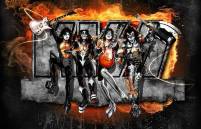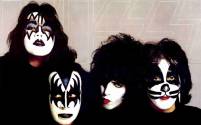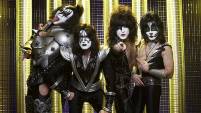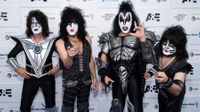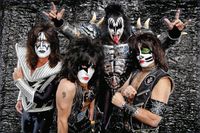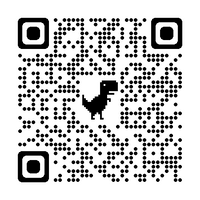Kiss (often styled as KISS) is an American Hard rock band formed in New York City in January 1973 by Paul Stanley, (Stanley Eisen) Gene Simmons (Chaim Witz) and the band's original manager, Lew Linet. Well known for its members' face paint and stage outfits, the group rose to prominence in the mid-to-late 1970´s with their elaborate live performances, which featured fire breathing, blood-spitting, smoking guitars, shooting rockets, levitating drum kits, and pyrotechnics. The band has gone through several lineup changes, with Paul Stanley and Gene Simmons as the only remaining original members.
The original and best-known lineup consisted of Paul Stanley (lead vocals and rhythm guitar), Gene Simmons (vocals and bass guitar), Ace Frehley (Paul Daniel Frehley) (lead guitar and vocals) and Peter Criss (George Peter John Criscuola) (drums and vocals).
With their make-up and costumes, they took on the personae of comic book-style characters: The Starchild (Stanley), The Demon (Simmons), The Spaceman or Space Ace (Frehley) and The Catman (Criss). Due to creative differences, both Criss and Frehley had departed the group by 1982.
In 1983, Kiss began performing without makeup and costumes, thinking that it was time to leave the makeup behind. The band accordingly experienced a minor commercial resurgence, and their music videos received regular airplay on MTV. Drummer Eric Carr, who had replaced Criss in 1980, died in 1991 of a rare type of heart cancer and was replaced by Eric Singer. In response to a wave of Kiss nostalgia in the mid-1990´s, the band announced a reunion of the original lineup in 1996, which also saw the return of their makeup and stage costumes. The resulting Alive/Worldwide Tour was commercially successful. Criss and Frehley have both since left the band again and have been replaced by Eric Singer and Tommy Thayer, respectively.
Kiss has sold more than 100 million records worldwide, including 25 million RIAA-certified albums. On April 10, 2014, Kiss was inducted into the Rock and Roll Hall of Fame.
Early years (1971-1975)
Kiss traces its roots to Wicked Lester, a New York City-based rock band led by Gene Simmons and Paul Stanley. They recorded one album, which was shelved by Epic Records, and played a handful of live shows. Simmons and Stanley, feeling that a new musical direction was needed, abandoned Wicked Lester in 1972 and began to form a new group.
In late 1972, Simmons and Stanley came across an ad in the East Coast version of Rolling Stone placed by Peter Criss, a veteran drummer from the New York City scene who had previously played in the bands Lips and Chelsea. Gene Simmons and Paul Stanley met him in a nightclub where he was playing drums. After hearing Criss sing, they thought of him being in the band. Criss then auditioned for and later joined the new version of Wicked Lester. The trio focused on a much harder style of rock than Wicked Lester played. They also began experimenting with their image by wearing makeup and various outfits. In November 1972, the trio played a showcase for Epic Records A&R director Don Ellis, in an effort to secure a record deal. Although the performance went well, Ellis disliked the group's image and music.
In early January 1973, the group added lead guitarist Ace Frehley. Frehley impressed the group with his first audition, although he showed up wearing two different colored sneakers, one red and one orange. A few weeks after Ace Frehley joined, Wicked Lester changed their name to Kiss.
Stanley came up with the name while he, Gene Simmons, and Peter Criss were driving around New York City. Peter Criss mentioned that he had been in a band called Lips, so Stanley said something to the effect of "What about Kiss?" Frehley created the now-iconic logo, making the "SS" look like lightning bolts, when he went to write the new band name over "Wicked Lester" on a poster outside the club where they were going to play. Paul Stanley designed the logo with a Sharpie and a ruler and accidentally drew the two S's unparallel because he did it "by eye." The art department asked him if we wanted it to be redrafted to be perfect and he said, "It got us this far, let’s leave well enough alone. Our number one rule has always been no rules.”
The runic letters happened to look similar to the insignia of the Nazi SS, a symbol that is outlawed in Germany by the section 86a of the German criminal code. Since 1979 most of the band's album covers and merchandise in Germany have used an alternate logo, in which the letters "SS" look like the letters "ZZ" backwards. This logo is also used in Austria, Switzerland, Poland, Lithuania, Hungary, and Israel to avoid controversy.
The band's name has repeatedly been the subject of rumours pertaining to alleged hidden meanings. Among these rumours are claims that the name is an acronym for "Knights In Satan's Service", "Kinder SS", or "Kids In Satan's Service". Simmons has denied all of these claims.
The first Kiss performance was on January 30, 1973, for an audience of three at the Popcorn Club (renamed Coventry shortly afterwards) in Queens. For the first three gigs, January 30 to February 1, they wore little to no makeup; the iconic makeup designs associated with Kiss made their debut during the March 9–10 shows at The Daisy in Amityville, New York. On March 13 of that year, the band recorded a five-song demo tape with producer Eddie Kramer. Former TV director Bill Aucoin, who had seen the group at a handful of showcase concerts in the summer of 1973, offered to become the band's manager in mid-October. Kiss agreed, with the condition that Aucoin sign the band to a record label within two weeks. On November 1, 1973, Kiss became the first act signed to former teen pop singer and Buddah Records executive Neil Bogart's new label, Casablanca Records.
The band entered Bell Sound Studios in New York City on October 10, 1973 to begin recording their first album. On December 31 the band had their official industry premiere at the Academy of Music in New York City, opening for Blue Öyster Cult. It was at this concert that Gene Simmons accidentally set his hair (which was coated in hairspray) ablaze for the first of many times while performing his fire-breathing routine.
Kiss' first tour started on February 5, 1974 in Edmonton, Alberta, Canada, at the Northern Alberta Jubilee Auditorium, as an opening act. The band's self-titled debut album was released on February 18. Casablanca and Kiss promoted the album heavily throughout the spring and summer of 1974. On February 19, the band performed "Nothin' to Lose", "Firehouse", and "Black Diamond" on ABC's Dick Clark's in Concert (aired March 29), their first television appearance. On April 29, the band performed "Firehouse" on The Mike Douglas Show. This broadcast included Gene Simmons's first televised interview, a conversation with Mike Douglas in which Gene Simmons declared himself "evil incarnate", eliciting uncomfortable reactions from a confused studio audience. Fellow guest Totie Fields said it would be humorous if, beneath all the make-up, Gene Simmons was "just a nice Jewish boy". Gene responded, "You should only know", to which Fields replied, "I do. You can't hide the hook", a reference to the stereotypical "Jewish" nose.
Despite the publicity and constant touring, Kiss initially sold just 75,000 copies. Meanwhile, the group and Casablanca Records were losing money quickly. The band (while touring) stopped in Los Angeles in August 1974 to begin recording their second album, Hotter Than Hell, which was released on October 22, 1974. The only single, "Let Me Go, Rock 'n' Roll", failed to chart, and the album stalled at No. 100.
With Hotter Than Hell quickly dropping off the charts, Kiss was pulled from their tour to quickly record a new album. Casablanca head Neil Bogart stepped in to produce the next album, trading in the murky, distorted sound of Hotter Than Hell for a cleaner and slightly poppier sound. Dressed to Kill, released on March 19, 1975, fared slightly better commercially than Hotter Than Hell. It also contained what later became the band's signature song, "Rock and Roll All Nite".
Although Kiss albums had not proved to be big sellers, the band was quickly gaining a reputation for their live performances. Kiss concerts featured such spectacles as Gene Simmons spitting "blood" (an effect made primarily from raw egg whites, strawberry syrup, and red food colouring) and "breathing fire" (spitting flammable liquid at a torch), Ace Frehley soloing as his guitar burst into flames (light and smoke bombs placed inside the guitar), Peter Criss's elevating drum riser that emitted sparks, Paul Stanley's Pete Townshend-style guitar smashing, and pyrotechnics throughout the show.
By late 1975, Casablanca was almost bankrupt, and Kiss was in danger of losing their record contract. Both parties desperately needed a commercial breakthrough if they were to survive. That breakthrough came in an unlikely form the double live album Alive!.
Rise to prominence (1975-1978)
Kiss wanted to express the excitement felt at their concerts (which their studio albums had so far failed to do) with their first live album. Compiled from May–July concerts in Detroit, Cleveland and Wildwood, NJ and released on September 10, 1975, Alive! achieved Gold status and spawned Kiss' first top 40 single: a live version of "Rock and Roll All Nite". It was the first version of the song with a guitar solo, and this recording has become the best-known version. It is also the basis of most covers, such as the cover by Poison in 1987. In recent years the band admitted that additional audience noise had been added to the album, as well as overdubs on select guitar and vocal spots, not to deceive fans, but to add more "excitement and realism" to the record.
The success of Alive! not only brought Kiss the breakthrough they had been seeking, but arguably saved Casablanca, which was close to bankruptcy. Following this success, Kiss partnered with producer Bob Ezrin, who had previously worked with Alice Cooper. The result was Destroyer (released March 15, 1976), Kiss's most musically ambitious studio album to date. Destroyer, with its rather intricate production (using an orchestra, choir, and numerous tape effects), was a departure from the raw sound of the first three studio albums. Album art was designed by Ken Kelly, who had drawn Tarzan, Conan the Barbarian and also produced album covers for acts such as Rainbow and Manowar. While the album sold well initially and became the group's second gold album, it quickly dropped down the charts. Only when the ballad "Beth", the B-side to the single "Detroit Rock City", began to gain more airplay on FM radio did the album's sales rebound. The single was subsequently reissued with the A and B-sides reversed. "Beth" peaked at number seven on the Billboard Hot 100, and its success led to an increase in sales for both the album (which achieved platinum status by the end of 1976) and concert tickets.
In October 1976, Kiss appeared on The Paul Lynde Halloween Special, lip-synching "Detroit Rock City", "Beth", and "King of the Night Time World". The show, co-produced by Bill Aucoin, helped introduce Kiss to an even wider audience. In addition to the three songs, Kiss was the subject of a brief comedic "interview" conducted by Paul Lynde. This included Paul Lynde noting, when hearing the member's first names, "Oh, I love a good religious group." The group was introduced to Lynde by Margaret Hamilton, reprising her character of the Wicked Witch of the West from The Wizard Of Oz.
Two more highly successful studio albums were released in less than a year: Rock and Roll Over (November 11, 1976) and Love Gun (June 30, 1977). A second live album, Alive II, was released on October 14, 1977. All three albums were certified platinum soon after their release. Between 1976 and 1978, Kiss earned $17.7 million from record royalties and music publishing. A 1977 Gallup poll named Kiss the most popular band in America. In Japan, Kiss performed five sold-out shows at Tokyo's Budokan Hall, breaking the previous record of four held by The Beatles.
In May 1977, Kiss made their first of many comic appearances in Howard the Duck issue 12, published by Marvel Comics. This served as a precursor to many more Kiss-related comics, initially published by Marvel.
The first Kiss compilation album, Double Platinum, was issued on April 2, 1978. This double album included many remixed versions of their hits, as well as "Strutter '78", a re-recorded version of a song from the group's first album. At Neil Bogart's request, this version of the song featured a disco influence.
During this period, Kiss merchandise became a substantial source of income for the group. Some of the products released included a pair of comic books issued by Marvel (the first one of which contained ink mixed with actual blood donated by the group), a pinball machine, dolls, "Kiss Your Face Makeup" kits, Halloween masks, board games, lunchboxes, trading cards, and many other pieces of memorabilia. Membership in the Kiss Army, the band's fan club, was in the six figures. Between 1977 and 1979, worldwide merchandise sales (in-store and on tour) reached an estimated $100 million.
Four solo albums (1978)
Kiss were at their commercial peak by 1978. Alive II was the band's fourth platinum album in just under two years, and the ensuing tour had the highest average attendance (13,550) in the group's history. In addition, Kiss' gross income for 1977 was $10.2 million. The group, along with manager Bill Aucoin, sought to take the band to the next level of popularity. To that end, an ambitious, two-pronged strategy was devised for 1978.
The first part involved the simultaneous release of four solo albums from the members of Kiss. Although Kiss has claimed that the solo albums were intended to ease rising tensions within the band, their 1976 record contract did in fact call for four solo records, with each of them counting as half an album toward the group's five-record commitment. Each album was a solo effort (none of the group appeared on another's album), and were all released and marketed as Kiss albums (with similar cover art and poster inserts). It was the first time that all current members of a rock band had released solo albums on the same day.
For the band members, it was a chance to showcase their individual musical styles and tastes outside of Kiss, and in some cases to collaborate with contemporary artists. Paul Stanley's album and Ace Frehley's album were most similar to Kiss' hard rock style, while Peter Criss his album featured an R&B style with multiple ballads. Gene Simmons his album was the most eclectic of the four, featuring Hard rock, ballads, Beatles-influenced pop, and a cover of "When You Wish upon a Star" from the Disney film Pinocchio. Gene Simmons' many collaborators included Aerosmith's Joe Perry, Cheap Trick's Rick Nielsen, the Doobie Brothers' Jeff "Skunk" Baxter, Donna Summer, Janis Ian, Helen Reddy, Bob Seger, Katey Sagal and his then-girlfriend Cher.
The solo albums were released on September 18, 1978. Casablanca Records spent $2.5 million on the marketing campaign for the albums, and announced they were shipping five million copies, guaranteeing platinum status. All four solo albums made it into the Top 50 of the Billboard album chart. The albums each sold about as many copies as Love Gun alone. Of the four, Ace Frehley's album was the most successful, and spawned the only hit single with a cover of "New York Groove", written by Russ Ballard and originally performed by Hello.
The second part of Kiss' and Bill Aucoin's plan called for the band to appear in a film that would cement their image as larger-than-life rock and roll superheroes. Filming commenced in the spring of 1978. Although the project was proposed to the band as a cross between A Hard Day's Night and Star Wars, the final result fell far short of those expectations. The script underwent numerous rewrites, and the band (particularly Peter Criss and Ace Frehley) grew increasingly frustrated with the film making process.
The final product, entitled Kiss Meets the Phantom of the Park, debuted on NBC on October 28, 1978. Despite scathing reviews, it was one of the highest-viewed TV films of the year. It was released theatrically, after many changes, outside the U.S. in 1979 under the title Attack of the Phantoms. The band members were unhappy with the finished film, and would speak about their film making experience in later interviews with a mix of humorous embarrassment and regret. They felt that the film portrayed them more as clowns than superheroes. The artistic failure of the film led to a rift between the band and Bill Aucoin. It has been only sporadically available on home video; currently, a version of the film is available on the compilation DVD Kissology Volume Two: 1978–1991.
Albums
Members
Kiss (1974)
Hotter than Hell (1974)
Dressed to Kill (1975)
Destroyer (1976)
Rock and Roll Over (1976)
Love Gun (1977)
Gene Simmons (1978)
Ace Frehley (1978)
Peter Criss (1978)
Paul Stanley (1978)
Dynasty (1979)
Unmasked (1980)
Music from "The Elder" (1981)
Creatures of the Night (1982)
Lick It Up (1983)
Animalize (1984)
Asylum (1985)
Crazy Nights (1987)
Hot in the Shade (1989)
Revenge (1992)
Carnival of Souls: The Final Sessions (1997)
Psycho Circus (1998)
Sonic Boom (2009)
Monster (2012)
Paul Stanley – rhythm guitar, vocals (1973–present)
Gene Simmons – bass, vocals (1973–present)
Tommy Thayer – lead guitar, backing vocals (2002–present)
Eric Singer – drums, percussion, backing vocals (1991–1996, 2001−2002, 2004–present)
Former members
Ace Frehley – lead guitar, vocals (1973–1982, 1996–2002)
Peter Criss – drums, vocals (1973–1980, 1996–2000, 2002–2004)
Eric Carr – drums, vocals (1980–1991; died 1991)
Vinnie Vincent – lead guitar, backing vocals (1982–1984)
Mark St. John – lead guitar, backing vocals (1984; died 2007)
Bruce Kulick – lead guitar, vocals (1984–1996)
